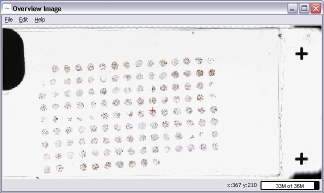HSV Threshold
The class HSVThreshold is a tool for clustering problems in HSV (Hue,
Saturation, and Value) color space for color-based pixel separation. The
main purpose of this tool is to support semi-automated color-based
segmentation. Particularly, this tool provides users the decision support
about valid pixel value ranges for specific types of object detection.
Description:
The class operates in three ranges of HSV values. Points within the
user-specified value ranges are appeared in the result image, both as RGB
and HSV images. In each scrollbar, a user can adjust the upper and lower
limits of the pixel values, and can fix the dynamic value range by
checking the “Fix Range” option. For example, the lower/upper limit will
move automatically while keeping the same dynamic value range when
changing the upper/lower limit.

Setup: By default, both RGB and HSV image are displayed from the
main Im2Learn frame. The two windows dynamically show the classified
images when a user adjusts the threshold value ranges.


For large image processing, such as “svs” format, a user can directly load
the image into the HSV threshold tool independently from the main Im2Learn
frame by pressing “Load” button. If a sub-sampled overview image is
available, as a same filename with “tif” extension, an overview window
will be displayed where a user can interactively select the currently
displayed region (marked as red cross).

Run: First, select a sub-region from the overview image to load a
200 by 200 pixel neighborhood from the large image to the RGB and HSV
windows. Next, change the Hue, Saturation, and Value range to acquire the
thresholded image. The number of valid (displayed) pixels is shown in the
title of the tool as “Positive pixel count” with the percentage with
respect to the total number of the pixels in the sub-region.
“Change
Region” button can be used to load an overview image with different
filename. Note that the overview image has to be a 1:200 sub-sampled image
from the original svs image, for example, an image sub-sampled by the
factor of 200.